The Great Cincinnati Courthouse Riots of 1884
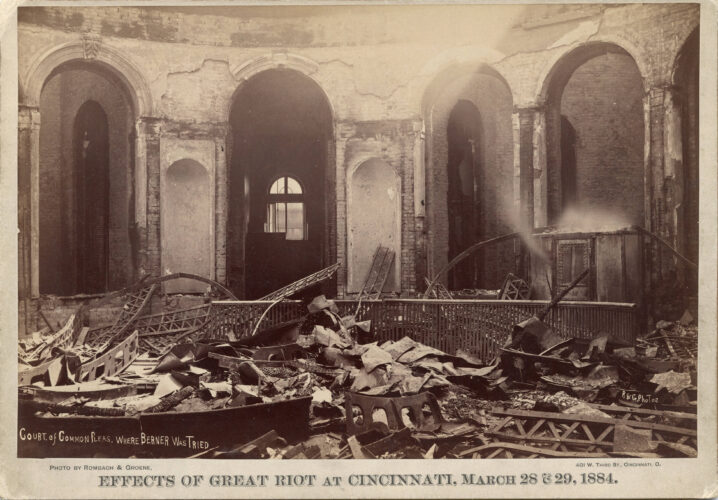
On Christmas Eve, 140 years ago, two men committed a heinous murder that would be the catalyst for the bloodiest riots in Cincinnati’s history. This is the story of the Great Cincinnati Courthouse Riots, of 1884.
In January 1884, after the festivities of Christmas, the body of William H. Kirk was found in a ditch near a suburb of Cincinnati. Kirk was a local horse dealer who employed two men by the names of William Berner and Joe Palmer. Detectives quickly gathered enough evidence to arrest the two men, who confessed to murdering Kirk for his money, “they secured about $245, all but $70 of which they spent in rioting. The gallows is too good for such villains.” (Milan Advertiser, 1884, p. 2) The two men were to be tried separately and when William Berner’s trial began the citizens of Cincinnati were sure that a swift guilty verdict and execution would ensue.
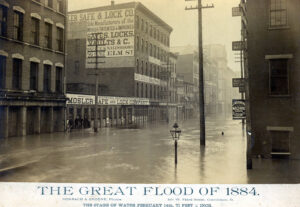
To provide context for the events to come, it is important to understand that corruption was a serious problem in the city at the time. Local leaders were notorious for controlling elections and manipulating judges and juries. As a result, the city was experiencing a crime wave, with two murders occurring every week. The citizens were sickened by criminals avoiding punishment through bribery and other means. This, compounded by the recent devastating floods fueled the frustration of the citizens living in unsafe and untenable conditions.
So, when the jury returned a manslaughter verdict, and the judge handed William Berner a twenty-year sentence, the public was outraged. They had been following the trial closely and read newspaper coverage of compelling testimony of those witnessing Berner’s admission of premeditation to commit the act of murder.
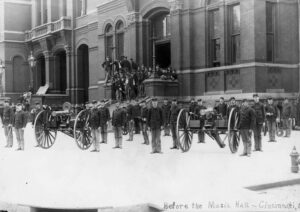
On Friday, March 28th, prominent members of the community organized a public meeting in the Music Hall. Impassioned speeches were made regarding the appalling sentence and strong resolutions were adopted, as the citizens cried for a call to action. The adjournment of the meeting sent heated attendees directly to the jail, believing Berner to still be there. If the law would not execute Berner for his crimes, they would.
Unbeknownst to the angry mob, Berner had been disguised by guards to quickly transfer him to the Ohio Penitentiary, in Columbus. The crowd, at the jail and courthouse, numbered in the thousands. They forced their way through the gates, using barrels of coal oil to set fires and stones and pistols to break windows, and pass through the guards at the entrances. Those in the crowd, that learned of Berner’s transfer, charged to the train station, “before the train could move, a rush was made for the prisoner, by a large crowd that had gathered at the Station. One of the officers was mistaken for the prisoner, and severely beaten, while Berner, who was not handcuffed, rushed through the ladies car, leaped from the train and escaped.” (The Circleville Democrat and Watchman, 1884, p. 2)
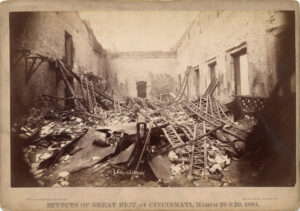
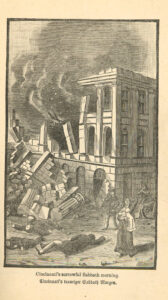
The crowds finally dispersed, late Friday evening, and Saturday morning Governor Hoadly was called upon to assert the power of State. Regiments of militia were ordered to Cincinnati, including the Ohio National Guard. Saturday evening brought more rioting and unrest. The mob started by rolling in barrels of coal oil and setting them on fire. The flames went unchecked causing the court rooms, law library, public offices, and public records to be destroyed. “While the flames were raging, the wild mob, wholly beyond control or reason, filled the street, and seemed bent upon destruction, pure and simple. During the night many were killed and wounded. The continual firing of musketry and repeated fusillades from the Gatling gun could not fail to result in widespread death and destruction.” (The Circleville Democrat and Watchman, 1884, p. 2)
On Sunday, many feared that there would be a repeat of the rioting from the previous night. The military stood guard, but noisy demonstration amounted to nothing. By Monday, order was restored, and the militia left the city. The riots ended with the loss of life totaling 56 and 300 were wounded.
This is not the end of the story, however, for Joe Palmer was yet to be tried for his participation in William Kirk’s murder. The difficulty in his case was finding jurors who had not made up their minds. It comes to no surprise that once impartial jurors were found, Palmer was quickly found guilty of first-degree murder and hung for his crimes on July 15, 1885. Berner was eventually recaptured and taken to the Ohio Penitentiary, where he served 11 of his 20-year sentence. Upon release he moved to Indiana where he died, in 1941, at the age of 74.
As for the courthouse, the only remaining parts of the original structure are the immense stone walls. A bill was passed to create a board of trustees to oversee the reconstruction of the courthouse. In January 1887, the Bar Association recognized the trustees and architect for their work in the rebuilding.
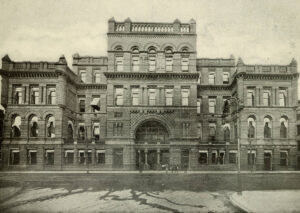
Sources:
(1884, January 5). The Milan Advertiser., 14(40), 1. https://ohiomemory.org/digital/collection/p16007coll103/id/4759
(1884, April 4). The Riot at Cincinnati. The Circleville Democrat and Watchman, 22(2434), 2. https://ohiomemory.org/digital/collection/p16007coll45/id/1230
Thank you to Aimee Truitt, Catalog & Metadata Coordinator at the Ohio History Connection, for this week’s post!



Leave a Reply
You must be logged in to post a comment.